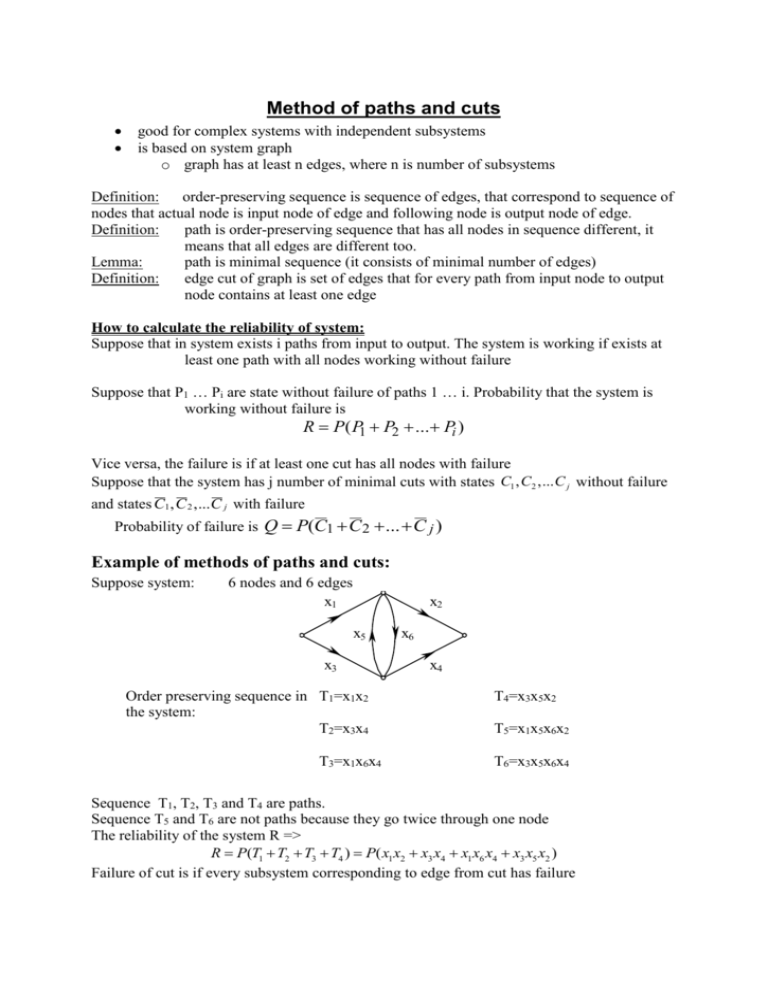System with backup
advertisement

Method of paths and cuts good for complex systems with independent subsystems is based on system graph o graph has at least n edges, where n is number of subsystems Definition: order-preserving sequence is sequence of edges, that correspond to sequence of nodes that actual node is input node of edge and following node is output node of edge. Definition: path is order-preserving sequence that has all nodes in sequence different, it means that all edges are different too. Lemma: path is minimal sequence (it consists of minimal number of edges) Definition: edge cut of graph is set of edges that for every path from input node to output node contains at least one edge How to calculate the reliability of system: Suppose that in system exists i paths from input to output. The system is working if exists at least one path with all nodes working without failure Suppose that P1 … Pi are state without failure of paths 1 … i. Probability that the system is working without failure is R P( P1 P2 ... Pi ) Vice versa, the failure is if at least one cut has all nodes with failure Suppose that the system has j number of minimal cuts with states C1 , C2 , ... C j without failure and states C1 , C 2 , ...C j with failure Probability of failure is Q P(C1 C 2 ... C j ) Example of methods of paths and cuts: Suppose system: 6 nodes and 6 edges x1 x2 x5 x3 Order preserving sequence in T1=x1x2 the system: T2=x3x4 T3=x1x6x4 x6 x4 T4=x3x5x2 T5=x1x5x6x2 T6=x3x5x6x4 Sequence T1, T2, T3 and T4 are paths. Sequence T5 and T6 are not paths because they go twice through one node The reliability of the system R => R P(T1 T2 T3 T4 ) P( x1 x2 x3 x4 x1 x6 x4 x3 x5 x2 ) Failure of cut is if every subsystem corresponding to edge from cut has failure State without failure for cut is if at least one subsystem corresponding to edge from cut is working without failure cuts of the systems are: C1=x1x3 C4=x1x5x4 C2=x2x4 C5=x3x6x1 C3=x1x5x3 C6=x3x6x2 C1, C2, C4, C6 – are minimal cuts C3, C5 – are not minimal because they contains the cut C1 from previous equation => reliability: R 1 Q 1 P(C1 C 2 C 4 C 6 ) 1 P( x1 x3 x2 x4 x1 x5 x4 x3 x6 x2 ) Problems of this method: (1) to find all path and cuts is complicated in complex systems => algorithms (2) bad identification of minimal cuts leads to wrong result (or prolong the calculation) (3) to determine the probability of union of event is not simple, because these events are not exclusive if the events are exclusive => the probability is simple sum Reliability estimation because the probability of union of 3 events A, B, C is: P( A B C ) P( A) P( B) P(C ) P( AB) P( AC ) P( BC ) P( ABC ) if ABC are mutually exclusive => exclude the combination of events in general it holds (for events A, B, C): P( A B C ) P( A) P( B) P(C ) two limit estimation of reliability R upper limit for case of dependent events reliability R P(T ) paths i i prob. of failure Q P(Ci ) cuts upper limit i combination: It has sence only if R 1 P(C i ) i lower limit P(Ti ) 1 and P(Ci ) 1 , otherwise it brings no information i i System from component with more states till now: system has two states failure general situation: correct working correct working failure different types Example 1.: diode failure states short-circuit break Example. 2.: transistor – combination of short-circuit and break of CB, BE transits Diode working without failure: x mutually excluded, only one state can be in one moment short circuit: x S break: x 0 P( x xS x0 ) P( x) P( xS ) P( x0 ) 1 a) probability of working without failure of diode is: P( x) 1 P( x S x0 ) 1 P( x S ) P( x0 ) b) system of two diodes in serial connection: 1 summary: 2 System without failure: 1) both diode O.K. 2) one diode short circuit Failure state: 1) both diode short circuit 2) at least one diode with break path of the system (positive combinations): x1 x2 x1 x 2 S x1 S x 2 cuts of the system (negative combinations) x1 x20 , x1S x2S , x1S x20 , x10 x2 , x10 x 2S , x10 x20 probability of working without failure (using paths): R P( x1x2 x1 x2S x1S x2 ) or (with cuts) R (1 P( x1 x20 x1S x 2S x1S x20 x10 x2 x10 x 2S x10 x 20 ) enumeration: probability of short circuit R p 2 2 pqS probability of working without failure together: p qS q0 1 probability of break failure c) 2 diodes in parallel: 1 2 paths: x1x2 , x1 x 20 , x 10 x2 R P( x1x2 x1 x 20 x 10 x2 ) for independent failures, both diode (substitution): probability of failure break R p 2 2 pq0 Remark: ► this method can be used for more state of components ► complicated construction of graphs for more states ► more simple is to directly enumerate paths and cuts Systems with time dependent failure probabilities steps: 1. to evaluate the probability of working without failure of system 2. to substitute the probability distribution to probability of components variation: 1. failures are independent – simple (approximation for big R) 2. failures are dependent: ►it is not possible to isolate the influence of the system structure and influence of the reliability of components solution ► cumulated probability distributions ► stochastic Markov models Serial system (time dependent probability distributions) the whole system is working if all components are working system of n independent components n R (t ) P ( xi ) i 1 suppose the components has the exponential distribution i t P ( xi ) e substitution n n common used equation R(t ) e i t e i t i 1 i 1 Remarks 1. probability distribution of the system has again the exponential distribution n i i 2. commonly used Weibull distribution for serial system (early stage (m<1) + normal work (m>1)) n mi tm t n t0 i i 1 t0 i R (t ) e e ´ i 1 t in general case if Zi (t ) i ( x ) dx then reliability of serial system is: 0 n n R (t ) e Z i ( t ) e Zi ( t ) i 1 i 1 Parallel system working without failure if at least one component is working (there is not failure of all components) n R (t ) 1 P ( xi ) i 1 using exponential distribution n R(t ) 1 (1 e i t ) i 1 P( xi ) 1 e it P( xi ) 1 e for Weibull distribution: tm t0 n R(t ) 1 (1 e tm t0 ) i 1 Remark serial system lower limit of working without failure parallel system upper limit of working without failure => for system with defined components complicated computation of working without failure with general distributions => simplification to compute numerically for short time interval substitution of complicated distributions with Taylor formula usually it satisfies to compute only the mean time to failure TS R(t ) dt 0 for serial system MTTF: exponential distribution: TS 1 n i i 1 1 n 1 1 TS ( 1) ( ) m m i 1 t0i Weibull distribution with the same parameter m for all component distribution for parallel system (it is more complicated): ► exponential distribution: (2 components in parallel): TS 1 1 1 2 1 1 2 (n – components in parallel): 1 1 1 1 TS ... 1 2 3 n 1 1 1 ... n 1 n 1 2 2 3 1 1 ... n 2 n 1 n 1 2 3 1 1 n 1 n i i ► for identical components in parallel and exponential distribution: 1 2 ... n n n n n 1 1 2 3 n 1 n TS ... 1 1 2 3 n Remark: in practice the computation of reliability for serial and parallel system is done only for exponential distribution – other distribution are very complicated to express! System with backup increase reliability backup of systems (or parts of the system) types of backups: — permanent — with switch — majority 1. Permanent backup: (with running backup or parallel backup) common failure – "break" => it exist backup (parallel) path common failure – "short-circuit" => backup is connecting in serial combination of previous x11 x11 x11 x21 x21 x21 xm1 xmn backup of system in global x11 x12 x1n x21 x22 x2n xm1 xmn backup of components suppose: the system is created from identical independent components, probability of working without failure is p backup of the whole system R 1 1 pn backup of components: m R 1 1 p m n with two components (backup of system (a), backup of components (b)) a) x1 x2 Input b) x'1 x'2 x1 x2 Input x'1 the ration: Output Ra 2 p 2 p 4 p 2 2 p 2 Output Rb p 2 2 p 2 x'2 Rb Ra Rb 2 p 2 21 p 2 1 and 0 p 1 Ra 2 p2 2 p2 2 p2 0 it’s true, that Remark 2. Rb 1 => parallel backup of components is better Ra the example can be generalized for n and m components in serial and parallel backup parallel backup of components is better (it holds for components with two state and failure is break general case can lead to opposite conclusion) Backup with switch (backup with immediate repair) – failure leads to switch bad component). Switch can recognize the failure state of the system. x1 input s x2 assumption: system has m identical independent components, where components in backup are not used if the system works properly => Poisson distribution f m; a a m a e m! m 0,1,2, ... for 2 components (no failure or one failure) RZ e a a e a 1 a e a if the probability of working without failure is p => according to Poisson distribution ~ probability of no failure is (m=0) => P e a substitution: RZ 1 ln p a ln p R 1 p(1-ln p) (with switch) 0,8 2p-p2 - (with parallel backup) 0,6 p - (without backup) 0,4 0,2 1 0,75 0,5 0,25 0 p Comparison of distribution without backup, with parallel backup and backup with switch Remark Parallel backup is worse then the backup with switch (in parallel system the backup system is working together with the original system => there is bigger chance for failure of backup system) - parallel backup ~ maximum (time to failure of component, time to failure of backup system) MTTF - with switch ~ sum of times of both components and backup system t using exponential distribution Px1 Px2 e : t Pswitch switch: RZ 1 t e t e 2 t parallel backup: RZ 2e influence of failure of the switch ! => probability of working without failure depends on the reliability of switch. => (failure of switch => failure of system) not exact 1. failure of the switch depends on failure of the system 2. switch has failure only when it is switching, if there is switch of the correct working subsystem, it is not failure a) x11 x12 x1n x21 x22 x2n xm1 xm2 xmn x11 x12 x1n x21 x22 x2n xm1 xm2 xmn b) a) whole seriál system b) components Backup with switch Remark: using ideal switch it is better to backup components then the whole system. Real switch decrease reliability and increase the price of the product computation of complex system (more then constant probability distribution) are too complicated => there are used method of statistical modeling or Markov models 3. Majority backup improvement of reliability of discrete (digital) systems (compared with analog systems it is more easy to compare the outputs of the system)! backup of digital system must increase the reliability for all possible outputs Computation of majority from odd number of systems suppose we have 3 systems: x11 input x21 M xm1 Majority backup output Suppose the majority comparator component (M) is working without failure and x1, x2, x3 are identical: from binomial distribution: R3 p3 3 p 2 1 p p 2 3 2 p , p is the probability of working component x for general majority from (2n+1) is: n N 2 n 1 2n 1 i p 1 p 2 n 1i R2 n 1 i i n 1 to compare the system of one component R3 p 3 3 p 2 1 p ratio R1 p and three components R3 p 3 2 p R1 R3 1 p 0,5 R1 it means that majority backup improve the reliability only if every component has reliability bigger then 0.5. This holds for every n 1 that only if p > 0.5 then R2 n1 1 R1 The figure shows the majority backup for components with exponential t distribution p e , for =1. The time t=0.69 represents time when R(t)=0.5 n R2n+1 1 n=0 n=1 n=2 n=4 0,5 n=0 n=1 n=2 n=4 e-t 0 0,5 0,69 1 1,5 t






